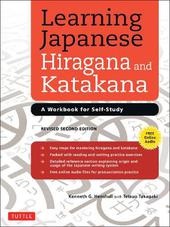
|
Learning Japanese Hiragana and Katakana: A Workbook for Self-Study
Paperback / softback
Main Details
| Title |
Learning Japanese Hiragana and Katakana: A Workbook for Self-Study
|
| Authors and Contributors |
By (author) Kenneth G. Henshall
|
|
By (author) Tetsuo Takagaki
|
| Physical Properties |
| Format:Paperback / softback | | Pages:128 | | Dimensions(mm): Height 254,Width 191 |
|
| Category/Genre | Languages |
|---|
| ISBN/Barcode |
9784805312278
|
| Classifications | Dewey:495.682421 |
|---|
| Audience | |
|---|
| Edition |
Second Edition
|
|
Publishing Details |
| Publisher |
Tuttle Publishing
|
| Imprint |
Tuttle Publishing
|
| Publication Date |
5 August 2014 |
| Publication Country |
United States
|
Description
Learning Hiragana and Katakana is a systematic and comprehensive Japanese workbook that can be used along with a Japanese language textbook or as a stand-alone resource to learn the Japanese alphabet ("kana"). Written Japanese combines three different types of characters: the Chinese characters known as kanji, and two Japanese sets of phonetic letters, hiragana and katakana, known collectively as kana, that must be mastered before the Japanese kanji can be learned. This best-selling book since 1990, is a favorite tool of students and teachers worldwide.
Author Biography
Kenneth G. Henshall has written many books on Japanese literature, history, culture, and language. A graduate of the universities of London (B.A. Hons), Sydney (Ph.D.), and Adelaide (Dip. Ed.), he is now Associate Professor of Japanese at the University of Canterbury in New Zealand. He has also taught at the universities of Auckland, Western Australia, California, and Waikato. He is the author of A Guide to Remembering Japanese Characters, and the lead author of the revised edition of A Guide to Reading and Writing Japanese. Tetsuo Takagaki is a graduate of the universities of Wakayama (B.A.) and San Francisco State (M.A.) and was a senior lecturer in Japanese at the University of Auckland. He also taught at the universities of Hawaii and Maryland, and at Tsuda College in Tokyo. He is the author of a number of publications on Japanese language and linguistics.
Reviews"Learning Japanese Hiragana and Katakana gives you an in-depth, behind-the-scenes look at kana. It covers the 46 basic symbols for each system, and the 61 modifications and combinations." --Eurolinguiste blog
|